In the fall of 1940 officials from the United States Defense Department made a quiet trip to Alexandria Bay, NY. It was a time when the likelihood that America would be drawn into World War II was gaining strength. Their mission was to examine the facilities of the Hutchinson Boat Works to determine if the firm possessed the capability to construct military craft if called upon. With the probability of war increasing, the Defense Department needed to identify boat building firms that were capable of building military craft. As a result of their early inspection, the officials determined that Hutchinson had the skilled staff, essential equipment, and location met their demanding criteria.
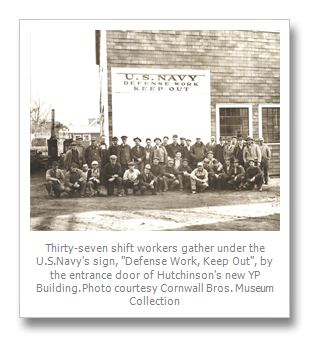
The Thousand Islands region had a long tradition of skilled boat building and an abundance of experienced craftsmen. Hutchinson's ideal location on the St. Lawrence River meant that their military craft could be delivered by water to coastal locations during nearly nine months of the year. The Department was impressed with Hutchinson's well-equipped machine shop where they had the capacity and experience to fabricate virtually everything necessary. Their report stated that the Hutchinson Boat Works had the capability to build significant vessels for the Navy.
In June 1941, a full six months before the Japanese attacked the United States Naval Base at Pearl Harbor, the Hutchinson Boat Works was assigned a special U.S. Navy contract for $170,000 to construct two 75-foot YP (Yard Patrol) training ships. Within a month the Government also provided sufficient funds for Hutchinson to construct a new building where they could build two standardized YP vessels, side by side, at the same time. The Department recommended that the new building should be 100 feet in length by 53 feet wide with a clear interior height of 26 feet. Construction began in early July 1941 and former workers remember that it was an immense exercise in logistics as one crew built the YPs while another crew, at the same time, erected the huge new building over them.
_8.png)
The Navy contract required a complete conversion from building varnished mahogany pleasure boats to building rugged 75-foot, fully armed, military vessels under rigid military specifications. The major responsibility to reorganize the Hutchinson shop and adding additional staff would fall upon the shoulders of three important Hutchinson supervisors; Cyriel Heath, Ray Rogers and Glenn Furness. The Defense Department contract further specified that both YPs had to be completed, launched and approved within 210 days from the contract's starting date. Hutchinson's military contract became a vital patriotic and economic windfall for Alexandria Bay and Jefferson County. The contract would require expanding Hutchinson's workforce by nearly ten times its normal size.
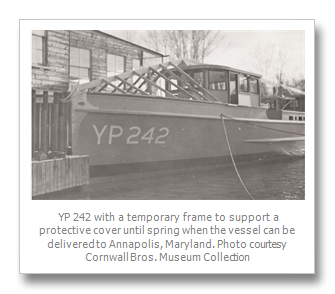
The local community was enthusiastic and affectionately referred to the YPs as the “Yippies.” The vessels needed to be rugged with strong wooden hulls made of heavy fir planking over white oak frames. The YPs were intended to serve as training vessels and were assigned to the United States Naval Academy in Annapolis, Maryland. The YPs were designed to be used for other services including rescue, dispatch, transport and, if necessary, even assault. The YP was a versatile military craft. The rigid military specifications and strict time table would present a serious challenge to any boat builder. Bert Hutchinson and his staff possessed years of experience maintaining and repairing very large yachts, commercial tour boats and enormous houseboats. During World War I, Hutchinson was awarded a government contract to build four Navy 1200-ton coal barges that were 115 feet long by 31 feet wide. As a result, the firm was familiar with the rigors of fulfilling government contracts. This experience gave Bert Hutchinson the experience necessary to successfully move forward with additional government contracts.
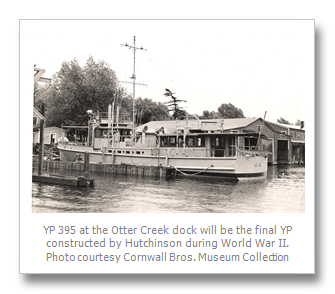
The standardized design of the YPs specified a large pilothouse located forward and a chart house cabin located just aft of midships on the main deck. The chart house would be equipped with chart cases, navigation equipment and a table large enough to spread out several nautical charts. In the forward section of the lower deck was located a well equipped galley with a dining table for the crew. Just forward of the galley the sleeping quarters were located with four bunks. In the fore peak of the cabin would be the location of the ship's lavatory. While Hutchinson's craftsmen followed the Navy specifications precisely, they often added varnished mahogany trim wherever possible throughout the interior cabins.
The YP's were powered by a pair of 250HP Diesel engines that provided the required speed of 18 to 20 miles per hour. The YP's were also equipped with a large generator to provide full electric power. There would be a husky heating plant to provide interior warmth during cold weather operations. Both the pilothouse roof and the chart house cabin roof were heavily reinforced to accommodate the weight and vibration of mounted firepower that would be installed by the Pine Camp engineers just before the vessels were delivered and released to the Navy.
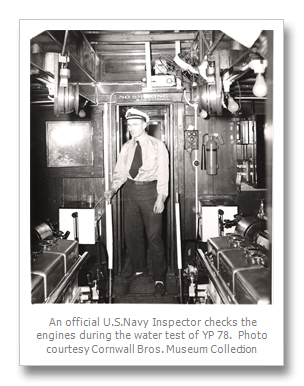
The first two YP's constructed by Hutchinson were officially assigned numbers YP-78 and YP-79 by the U.S. Navy. To accomplish the massive construction contract, many local craftsmen, carpenters and farmers were recruited to join the Hutchinson staff. To meet on the Government's rigid production schedule work took place on multiple shifts. The employment at Hutchinson's increased rapidly. It was reported in the local newspaper that over two hundred workers were employed during their peak military production period. The U.S. Army stationed at Pine Camp provided tight security at the Hutchinson Boat Yard twenty-four hours a day due to the constant threat of sabotage wherever defense work was undertaken.
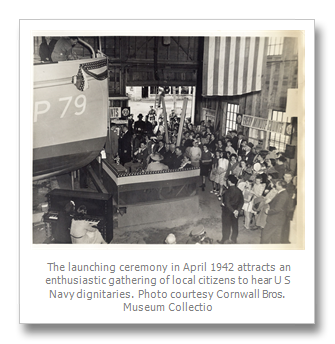
On April 20,1942 YP-79 was completed and ready to be launched just a few days ahead of YP-78. The launching was a big event for the greater Alexandria Bay community. Commander Hyde from the U.S. Naval Academy, Col. John Hall of Pine Camp and other government officials arrived for the special launching ceremony. The entire community was invited to attend the launching. The Vice Principal of Alexandria Bay's High School served as the Master of Ceremonies to introduce the officials. Bert Hutchinson and his shop supervisors, Ray Rogers (Machine Shop), Glenn Furness (Designer), Cyriel Heath (Finishing) and J. Hubert Hunt (Office Mgr.) were also recognized in the ceremony. Mrs. J.Hubert Hunt, wife of Hutchinson's Office Manager, was selected to crack the decorated bottle of champagne over the bow of YP-78 as the local High School Band played the Navy's popular theme, Anchors Aweigh. The launching was a complete success and established an important milestone for this proud St. Lawrence River community. It was a wonderful occasion that celebrated the patriotism and pride of local residents.
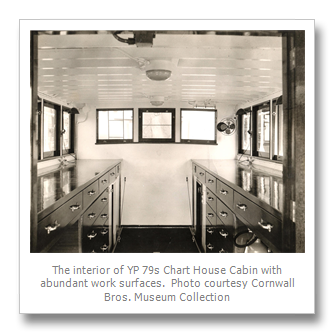
YP-78 would be the first in a series of vessels produced by Hutchinson for the United States Navy during World War II. In addition to building several 75-foot YPs, Hutchinson received additional contracts to build 38-foot buoy boats for the United States Navy. YP-78 and her Hutchinson sister ships represented an important moment in Alexandria Bay's boat building history. During the War, the Hutchinson Boat Works was awarded the Government's prestigious Army-Navy “E” Award for Excellence in recognition of their outstanding quality and their ability to meet every deadline.
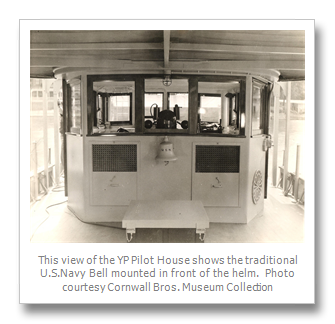
As the War wound down and Hutchinson's final contract was completed, they returned to building mahogany pleasure craft once more. One of the benefits of their military work for the Government was the addition of the large YP building. With the War ending there would be an abundant need for additional space to meet the peace time demand for new pleasure craft. In addition there would be a great need to restore many of the private cruisers that were acquired at the outset of the war to patrol America's coastal waters by the Coast Guard and the Navy. The private boats were always painted drab gray and often received rough duty. Hutchinson received numerous cruisers for restoration and reconditioning.
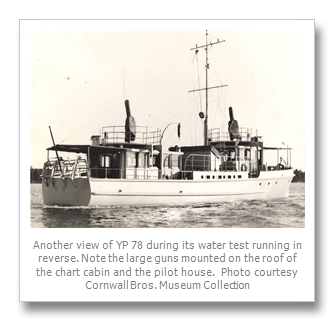
In the early postwar years Hutchinson concentrated on building their standardized 22-foot and 26-foot sport utility models as well as building a wide range of custom boats. It was in the early postwar years that they built the world-famous runabout, Pardon Me , the beautiful express cruiser, Gail IV and the sport fisherman, Danny Boy. By 1960 new wooden boat construction began to slow down due to the growing popularity of fiberglass boats from other builders. In 1964, Hutchinson built and delivered its final wooden boat. It was a beautiful 22-foot sport utility for Richard Macsherry of Alexandria Bay. Hutchinson's wooden boat building quietly came to an end after sixty-three years. They built fine wooden boats for more consecutive years than did Gar Wood, Hacker, Century and even the giant Chris-Craft. Hutchinson built marvelous wooden boats that are still prize winners in the most prestigious antique boat shows from Clayton to Lake Tahoe.
By Anthony Mollica
Anthony Mollica’s first wrote professionally in his teaching career in communications. Writing for pleasure evolved from his activities with the Antique and Classic Boat Society and the Antique Boat Museum as well as his life-long interest in the history of boat building in American. He has published articles in various marine periodicals including Classic Boating, ACBS Rudder, Gar Wood News, The Antique Boat Museum Gazette Annual, Motor Boating, Lakeland Boating and The Chris-Craft Brass Bell Quarterly. He is also the author of twelve published books, many of which are available in local book stores. In September 2010, TI Life reviewed Building Chris-Craft: Inside the Factories”. A book he wrote with Chris Smith, a member of the founding family. (See Anthony Mollica on our Publications page)